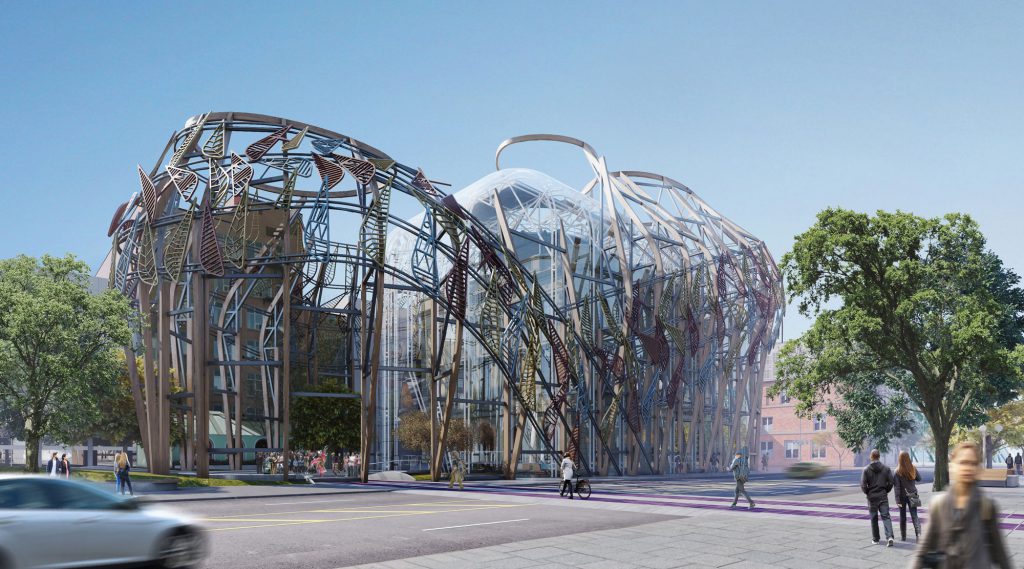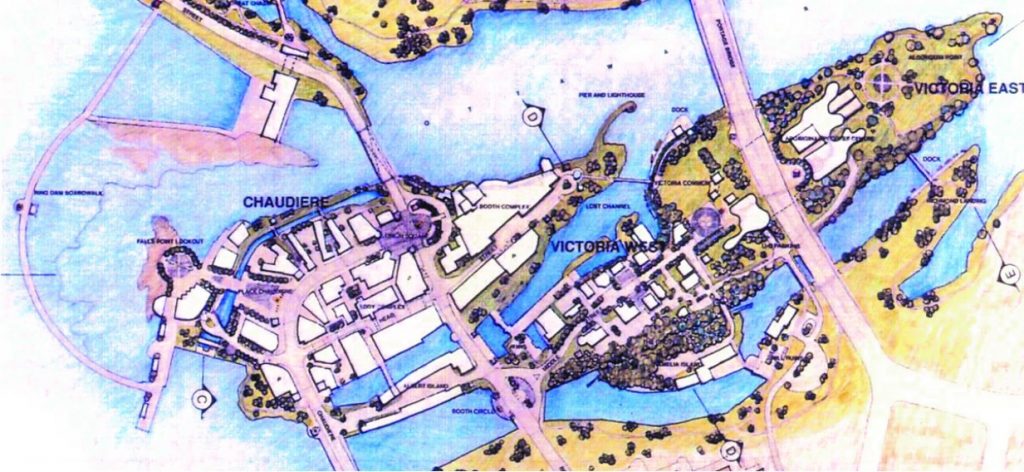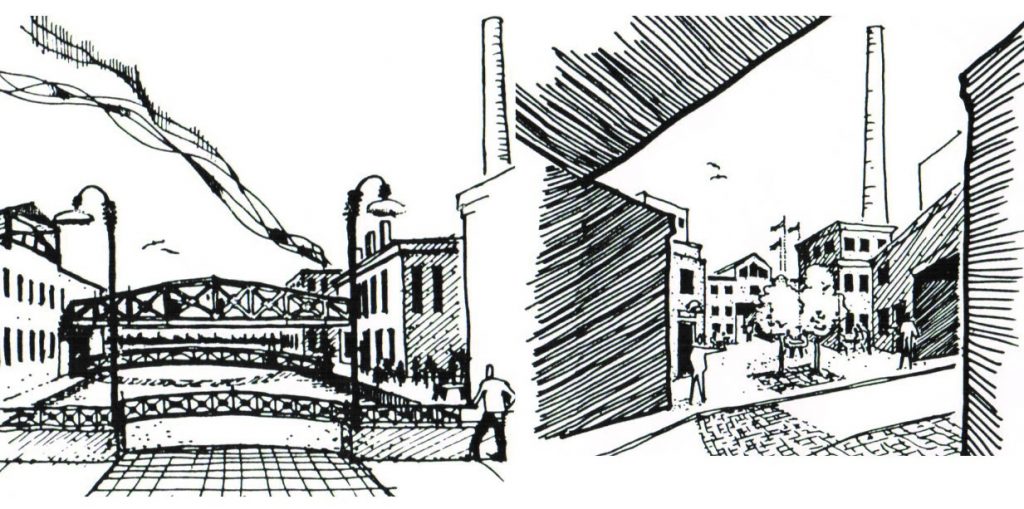As a globalized society, it is expected that one third of Canada’s population will be a visible minority by 2031 (Statistics Canada). In contrast to an increasingly diverse population (and in contrast to MTBA’s studio, which is over 70% female, from diverse cultures), the number of licensed architects is expected to remain predominantly white and male. This means there is a potential disconnect between those who design our built environment (architects) and those who live and use these spaces (the community).
MTBA’s earliest experience with “diversity training” came in 1989, when we were retained by the National Capital Commission (NCC) to develop the first comprehensive Master Plan for the Victoria and Chaudiere Islands Historic District, then a declining industrial brownfield and part of what was then termed “Core Area West” of the National Capital. Of course, the Chaudiere Falls and the archipelago of islands around it have been a sacred place for Indigenous Peoples for centuries. In the 1980’s, there were no budgets for engagement with Indigenous stakeholders, so MTBA took it upon ourselves to reach out to the Annishnabeg Algonquin peoples to get their views on how the Islands District should evolve over time, to diversify our perspective and add quality and value to our Plan.
Fast forward to 2021: The Royal Architectural Institute of Canada’s (RAIC) recent Indigenous Architecture and Design Symposium has contributed to an important conversation regarding Indigenous perspectives of our cities and buildings. MTBA’s Catherine McBain, M.Arch., Intern & Heritage Specialist, participated and her report forms the foundation of this article.

There is a need for adopting a framework at federal, provincial and municipal levels, that celebrates diversity and inclusion in architectural education and practice, to bridge the gap between architects and their communities. Additionally, culturally appropriate buildings and spaces in Indigenous cultures in Canada and abroad has become an important point of discussion. Indigenous visibility was explored in Canada’s first Indigenous-led exposition, UNCEDED: Voices of the Land, at the 2018 Venice Biennale. Initiatives implemented since are only furthering a call to action for architects and construction professionals to become aware of a long-overdue social issue and need to amplify Indigenous voices.
The RAIC’s 2-day symposium featured sessions led by Indigenous architects including Wanda Dalla Costa, Brain Porter, Kim Anderson, and Eladia Smoke. Each session proposed concepts for Indigenous design practices, proposing community collaboration as a status-quo for all future development. As a “nothing about us, without us” approach, community involvement in architectural practice and academia can foster deeper understandings of our society–not only as a concept to apply to Indigenous considerations in architecture, but all architecture that has a willingness to represent a specific community.
Important concepts related to sustainability and environmental stewardship were also at the forefront. Speakers introduced holistic environmental practices as foundational teachings embedded in Indigenous knowledge. It is made clear that as a profession, architects have a lot to learn from Indigenous Peoples about adopting holistic environmental practices to ensure a sustainable and resilient future. MTBA is currently in the process of updating their resource, Building Resilience: Practical Guidelines for the Sustainable Rehabilitation of Buildings in Canada, which focuses on the benefits of heritage conservation and the strong interrelationship between the natural and built environment. The Second Edition will include an updated set of best practices for sustainable building reuse, and will reflect changes in our “construction mindset” since its First Edition in 2016.
This harkens back to that 1989-90 Islands Master Plan by MTBA for the NCC: At that time, there were also no budgets for sustainability practices/design. Nevertheless, planning for the islands’ natural assets and best practices in urban design supported MTBA’s “green beyond mandate” design. Two full decades later, the Plan was put through a rigid test under LEED for Neighbourhood Development (LEED ND) and it scored at the Gold level. At that time, project lead Mark Thompson Brandt determined that, had resilience been part of the mandate, we could have exceeded LEED Platinum and beyond. To quote Brandt from 2010: “We could have easily approached regenerative-environment design, where our inspiration from the circular concepts and understanding of environmental stewardship of First Nations would have wonderfully infused our new development with Indigenous principles, bringing both the future and the heritage of this place back to it’s Indigenous foundations.”


These changes, however, require a “footing,” and there is an increasing need to restructure legislation, institutions and associations that make up the current architectural discipline in Canada. As a response, the RAIC has developed the Indigenous Task Force to assist in developing a framework for reconciliation. Part of these recommendations include encouraging provincial licensing bodies to foster better relationships with local Indigenous communities.
As a first step, the Ontario Association of Architects (OAA) will be hosting two webinar series on July 8th and July 22nd which will focus on tools for meaningful and effective collaboration practices with Indigenous entities. The July 8th series titled Step-by-step Wiidosendiwag: Imbedding Indigenous Perspectives, led by Eladia Smoke will present Indigenous perspectives that enhance well-being, by introducing frameworks to strengthen long-term relationships with people and places. The second series titled Terminology Tips to Respectfully Engage with Indigenous People, led by Kaitlin Ritchie and Rolando Aguilera, will discuss appropriate terminology to use when engaging with Indigenous Peoples in your community.
To register for the upcoming OAA webinar series here: 2021 OAA Webinar Series
To learn more about the RAIC’s Indigenous Task force: Indigenous Task Force | Royal Architectural Institute of Canada (raic.org)
Today and Tomorrow:
MTBA has been thinking in these terms for decades, but the world has evolved in the intervening time and new voices and attitudes are needed to take Canada to the next level in reconciliation, diversity thinking and Indigenous presence and inspiration. Catherine McBain, who undertook a work term at MTBA in 2020, was hired upon completion of her Master’s Thesis in June 2021, to join MTBA full time and to lead the firm’s budding diversity and indigenous engagement group, naturally part of our heritage, sustainability and community engagement specializations.
Catherine’s thesis project titled Decolonial Intersections of Conservation and Healing, focused on the territorial and architectural practices of the Indian Residential Schools System in Canada. Her project alludes to ‘illustrative futures’ where the conservation of landscapes, architecture and territories means designing encounters for healing and critical reflection. Proposed as a series of frictional embodied experiences, the project explores interventions that subvert the IRS memory, interrogating its socio-spatial hierarchies. The project explores three former residential schools, intentionally reconnecting spatial fragments, reclaiming territories, and subverting existing architectures. As a critique of Western heritage conservation practices, the futures ultimately suggest hybrid frameworks that suggest ontological connections with erased cultural landscapes.
